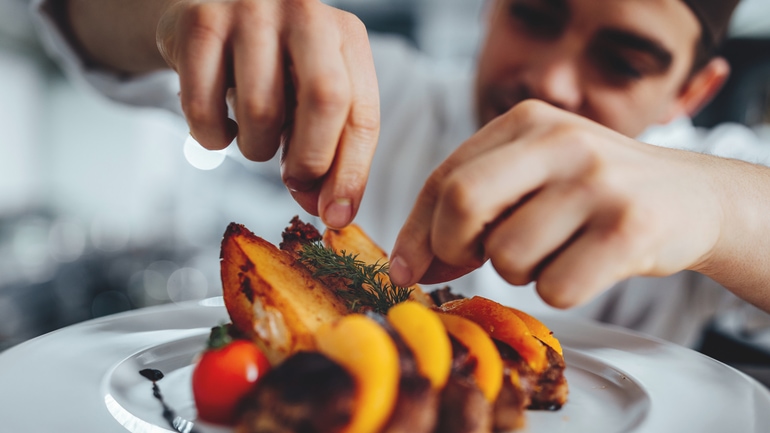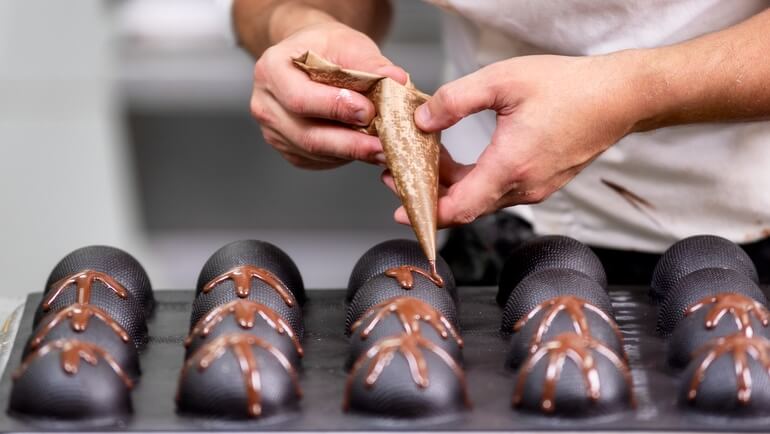In the restaurant industry, food plating and presentation are a key part of the guest experience.
Unfortunately, during a dinner rush, food plating is often one of the first things that gets overlooked. You end up being either too busy or too focused on the taste of the dishes – food presentation becomes a far away afterthought.
Don’t worry – you don’t need to have an advanced art degree to turn your dishes into gorgeous masterpieces! There are no hard and fast rules to “correct” plating, but there are several important ideas to keep in mind when preparing and plating your restaurant dishes.
In this article, we’ll go over everything you need to know to plate your food like a master chef, including:
- What food presentation and plating actually is
- Why it’s so important for your restaurant
- 11 easy plating tips and tricks
Bon appetit!
What Is Food Presentation and Plating?
Food presentation refers to the arrangement of food on the plate in a way that makes it appealing to the diner.
A plate should engage your diner’s senses and draw them into the experience as much as a painting in a gallery draws in the observer. Not only will a good presentation add value to your customer’s dining experience, but they’ll be more likely to post and share a meal on Instagram when it looks as good as it tastes!
The plate should carefully balance taste, texture, and color. By playing with these components, you can bring a sense of satisfaction to your diners as soon as the dish is delivered to the table – before they even take a bite. The plate can be either dressed with a sauce, topped with garnishing, or arranged in a quirky, fun style.
Why Good Food Presentation Is Important
There are many benefits to preparing an attractive plate of food. First and foremost, since cooking is a form of art, the final food presentation lets the chef get creative and stamp their own identity on the menu. You present a story to your diners to read with their eyes first, then with their taste buds. Food presentation and plating are also a way of tempting diners throughout the restaurant, who see the dish on its way to the table and immediately want to order the same.
From the management perspective, food plating and presentation is a simple way to provide diners a better dining experience. When done right, it can turn a dinner party into a great success and receive praise and recognition for your entire restaurant. Having a system in place for plating will also help when tracking inventory – if you know what is going into each plate instead of haphazardly dumping garnishes on a plate, you’ll know exactly how many ingredients are used up per dish.
Now, let’s take a closer look at why presenting your food attractively is substantial in your restaurant business.

Attract Customers and Elevate the Experience
The way food is presented has a big impact on how your diners perceive it. We all judge food even before we take a bite – for the most part, that judgment is entirely on how the food looks. Plus, having food that looks good can be a huge traffic driver. You can think about it this way: You could make a milkshake at home, but there’s a reason that Black Tap in New York constantly has a line out the door for their towering milkshakes.
Beyond driving traffic, plating and presentation are also a huge factor in perceived value – which impacts how much you can charge. When you put the extra care into your food presentation, diners are going to be willing to pay more. If we go back to New York, diners at Black Tap are lined up to pay anywhere between $15 to $18 for a milkshake. While you could get a milkshake for a few bucks at a drive-thru, people are willing – and waiting in line – to pay top dollar for a good looking milkshake.
Even if your dishes are the best in the city, they have to look the part as well.
Communicate the Quality of Your Restaurant
The way you plate food and present it communicates the quality and standards of your overall restaurant experience. When food is presented poorly, it can be perceived as a mismanaged kitchen staff or low-quality ingredients.
Top level food presentation instantly helps diners perceive your restaurant as high quality, before they even take a bite. The extra care and detail that goes into preparing it will directly influence a diner’s perception of your whole restaurant and your food.
Essential for Restaurant Marketing
It’s important to maintain your food aesthetics as much as your overall restaurant interior and exterior. We live in the age of social media where everything is shared online – including every drink, meal, and dessert. Foodie accounts are huge right now! Not maintaining the appearance of your food presentation could alienate these growing marketing opportunities.
For example, if people on Instagram don’t like the way your food looks on a plate (no matter how tasty it is), it likely won’t make it to their Instagram feed or story. When you miss out on people sharing your meals within their network, you’re also missing the chance to appear in front of potential new diners!
Food presentation is important for more than just social media shares on diner accounts – it’s important for your own profiles as well. In an increasingly digital age, having a well-rounded online profile is an opportunity to show diners what’s available at your restaurant. Whether you’re sharing expertly styled food on Instagram or adding it to your profile in review sites, make sure each dish looks good! After all, a picture is worth a thousand words!

Top 11 Food Presentation Tips for Your Restaurant
There are so many ways to serve and present food. But it’s the small details that make all the difference in ensuring your dish and restaurant stand out from the rest.
Here are 11 food plating tips that will help you step up your serving game.
1. Match with Your Restaurant Theme
The way you plate and present your food should reflect the type of restaurant you’re operating. So first, consider the theme of your restaurant.
If you’re running a small, ethnic restaurant, your guests expect a simple, rustic, hearty food presentation. But at a high-end, pricey and hip restaurant, your guests would expect to see some form of delicacy in your dish presentation – from the presentation on the plate to the dish it’s served on.
2. Choose the Right Tableware
The color and size of the tableware is important. If you’re new to food plating and styling, it’s best to keep it simple with white, ivory or light shades of tableware. This way you can experiment with the positioning of elements and embellish with garnishes or sauces without worrying about clashing colors.
Make sure to keep an eye out for cracked or broken tableware – it can be a complete turn-off to customers and unsafe to eat off of. Regularly conduct checks to either replace or fix damaged tableware.
3. Create Layers and Height
Start building up, not down or sideways. By layering and stacking food, you can add a lot of dimension to your plate.
When plating food, it’s a good rule of thumb to have three different heights. It helps fill up space and make food look bigger (without actually increasing the portion size). You can start by experimenting with three components and their heights: protein, starch, and vegetables.

4. Play with Textures
Using textures is a great way to create depth and dimension with your food presentation. This can be as simple as adding a delicate foam or sauces with a crunch on top. You can also drizzle dressing sparingly around the plate and place the meat in the middle.
5. Serve Smaller Portions
This is all about finding a delicate balance. Generally, smaller portions are more attractive and easier to style. If your plates are absolutely maxed out with food, it doesn’t leave a lot of room for presentation. But you want to make sure guests feel satisfied when they leave. There’s nothing worse than leaving a restaurant feeling hungry.
It all depends on the type of restaurant you are and the customers you attract. If diners aren’t expecting huge portions, you have some room to experiment and find a balance between a dish that fills them up and a food presentation that wows. According to the National Restaurant Association, serving smaller portion sizes is one of the top five most restaurant trends in 2019!
6. Slice Meat Horizontally
Try fanning out meat by slicing horizontally to show off its quality. The best way to do it is to slice on a 45-degree angle and against the grain of the meat, to provide a more tender cut.
7. Use Complimentary Colors
Color adds energy and contrast to your dish. Bright vegetables and fruits, such as beets, carrots, and cauliflower make a striking difference on a plate. Work with complementary colors (i.e. red and green) and try adorning salads and meats with banana leaves or citrus zest.
But be wary of colors that seem artificial. It’s typically seen as bad practice to serve a blue dish, because blue isn’t a color naturally seen in food.
8. Choose the Right Plates
A large plate is always a good idea since it gives you more space to work with, but avoid the pressure to completely fill up the plate! If you cover every part of a large plate, it will look messy and overcrowded – leave some breathing room.
You’ll also want to use different plate sizes for different dishes. For instance, large plates are a better fit for steaks, while an appetizer usually comes in smaller plates. If you use large plates for every portion, it can impact how much food diners feel they are getting.
9.Harmonize Garnish and Decoration
Garnishing and can add flavor and texture to your dish. It shouldn’t be an afterthought but rather an edible element that is purposely placed to balance the rest of the dish.
It may sound easy but the right garnish requires a lot of precision. Make sure you don’t overdo it. And make sure it’s edible – no server wants to explain to a guest that they can’t eat something on their plate.
Garnishes come in a variety of forms such as herbs, spices, edible flowers, sauces, creams, and citrus zest. You can even include them in dessert. For instance, if you’re serving mango ice cream, you can add a slice of mango in the center or corner of the scoop to give it some color, texture, and a fresh appearance.
10. Use the Right Tools to Serve
Using the right tools when plating food makes a big difference. You put a lot of effort into perfecting your dish, so use plating tools to match your hard work and attention to detail.
Here are some of the most basic plating tools you’ll need:
- Precision Spoons: With this tool, you can place sauces of other types of liquid food on the plate in the right amount you want. The spoons are unique in design – they have a much deeper well which allows you more control when pouring.
- Squeeze Bottles: This gives you even more control over sauces and liquids to create designs on your plate. Get artsy by adding swirls, dots, and other patterns to create a unique appearance.
- Decorating Brushes: Unleash your inner artist during the plating process. With brushes, you can create much more unique texture and other small details on your plates.
- Molds: Serve food that is in precise shapes, such as squares, circles, ovals or hearts.

11. Keep It Simple and Express Yourself
Free your mind! Most chefs recommend using white plates for food presentation. But you can always get creative and use plates and cutlery from natural materials like wood or stone. You can even take it a step further and serve food in unusual bowls and plates. For instance, serve soup in a coffee pot, or wine in a vase decanter. Be courageous and express the artist in you!
Styling and plating food might take time and a little patience, but the extra effort will pay off for your restaurant’s reputation and operations. Use these food plating tips, tricks, and techniques and start experimenting with different ways to improve your food presentation – and your bottom line!
Download our free inventory template
Sign up for our free weekly TouchBistro Newsletter







